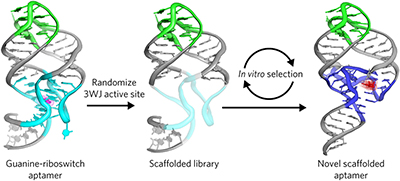Nature Chemical Biology ( IF 12.9 ) Pub Date : 2017-01-16 , DOI: 10.1038/nchembio.2278 Ely B Porter , Jacob T Polaski , Makenna M Morck , Robert T Batey

|
Allosteric RNA devices are increasingly being viewed as important tools capable of monitoring enzyme evolution, optimizing engineered metabolic pathways, facilitating gene discovery and regulators of nucleic acid–based therapeutics. A key bottleneck in the development of these platforms is the availability of small-molecule-binding RNA aptamers that robustly function in the cellular environment. Although aptamers can be raised against nearly any desired target through in vitro selection, many cannot easily be integrated into devices or do not reliably function in a cellular context. Here, we describe a new approach using secondary- and tertiary-structural scaffolds derived from biologically active riboswitches and small ribozymes. When applied to the neurotransmitter precursors 5-hydroxytryptophan and 3,4-dihydroxyphenylalanine, this approach yielded easily identifiable and characterizable aptamers predisposed for coupling to readout domains to allow engineering of nucleic acid–sensory devices that function in vitro and in the cellular context.
中文翻译:

循环RNA基序作为可遗传编码的小分子生物传感器的支架
越来越多的变构RNA设备被视为能够监测酶进化,优化工程化的代谢途径,促进基因发现和基于核酸的疗法的调节剂的重要工具。这些平台开发中的关键瓶颈是在细胞环境中具有强大功能的小分子结合RNA适体的可用性。尽管可以通过体外针对几乎任何所需靶标制备适体选择时,许多设备无法轻松集成到设备中,或者无法在蜂窝环境中可靠地运行。在这里,我们描述了一种新的方法,该方法使用了具有生物活性的核糖开关和小的核酶的二级和三级结构支架。当应用于神经递质前体5-羟基色氨酸和3,4-二羟基苯丙氨酸时,该方法可产生易于识别和表征的适体,易于与读出域偶联,从而可工程化在体外和细胞环境中起作用的核酸传感装置。































 京公网安备 11010802027423号
京公网安备 11010802027423号